Looking to transform your garden? There are countless plants out there that come in a variety of different colors, so you’re definitely spoiled for choice. However, if you want to add some dimension to your garden, why not choose some vines that have gorgeous yellow flowers? A splash of yellow can transform any garden or balcony into a beautiful natural oasis. And, of course, vines in particular hold a unique charm. They climb, cascade, and drape, adding vertical interest to any space. But now that you’ve decided on yellow flower vines, which ones should you choose for that brilliant burst of sunny color?
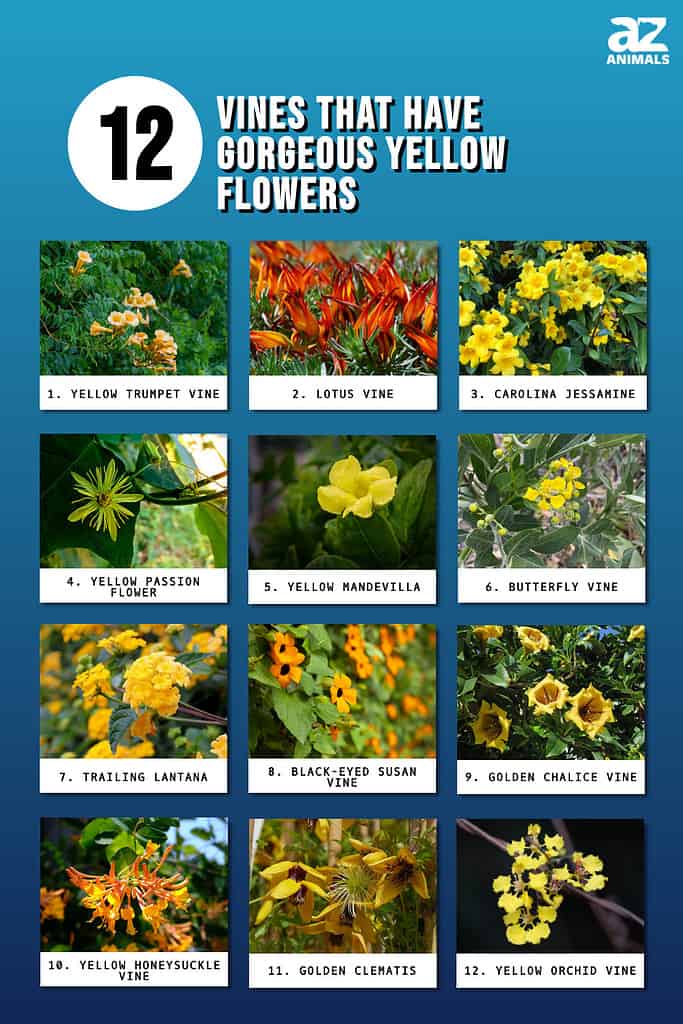
In this handy guide, we’ll explore 12 of the most gorgeous vines with lovely yellow flowers. Let’s bring some sunshine to your green corner!
1. Yellow Trumpet Vine (Campsis radicans)
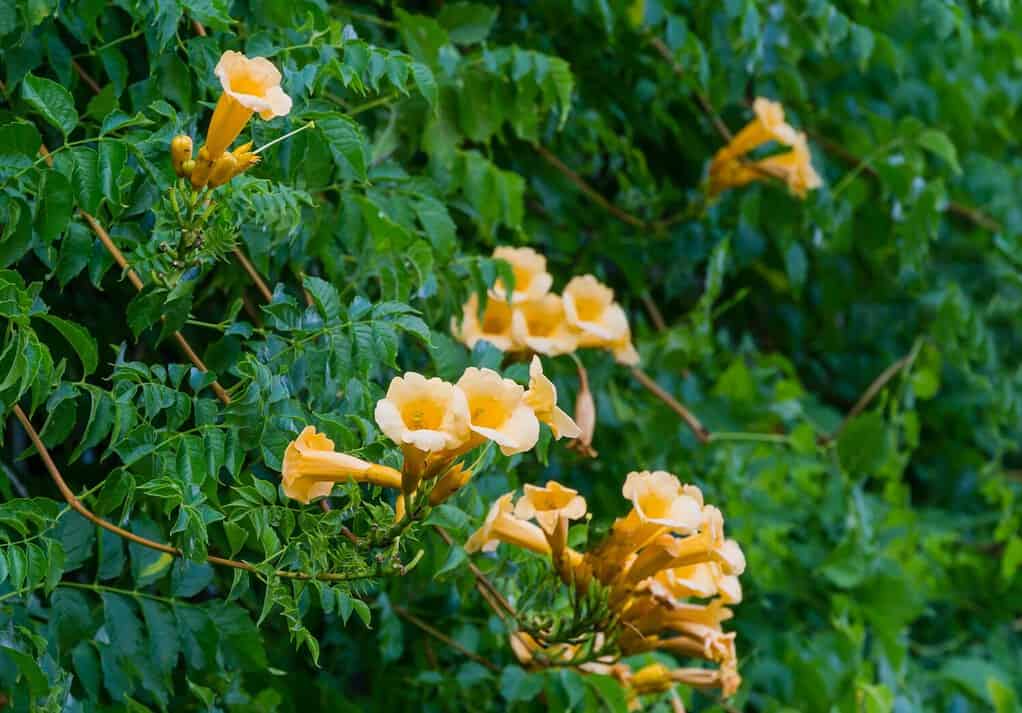
A gorgeous vine with yellow blossoms that attract pollinators to your garden is the yellow trumpet vine.
©Marinodenisenko/Shutterstock.com
Yellow trumpet vine is a standout, boasting vibrant golden-yellow, trumpet-like blooms that are about 3 inches long. These radiant flowers grace the plant all summer, offering a continual splash of color.
Hummingbirds are consistently drawn to them, ensuring a lively garden scene. After the blossoming period, eye-catching bean-like seed pods form. Its leaves are a glossy dark green on top and a matte green underneath, and they shed in the fall.
While it’s a favorite in Mediterranean-style gardens due to its stunning flowers, gardeners should be cautious. This vine tends to spread rapidly.
It’s been recognized with the esteemed Award of Garden Merit from the Royal Horticultural Society, a testament to its beauty and resilience.
For the best blooms, plant it in a sunny to partially shaded spot with decent drainage. Although it’s adaptable to various soil types, it flourishes best in moist, well-drained conditions.
It’s ideal for dressing up trellises, walls, or fences and thrives in USDA Zones 4-9.
2. Lotus Vine (Lotus maculatus)
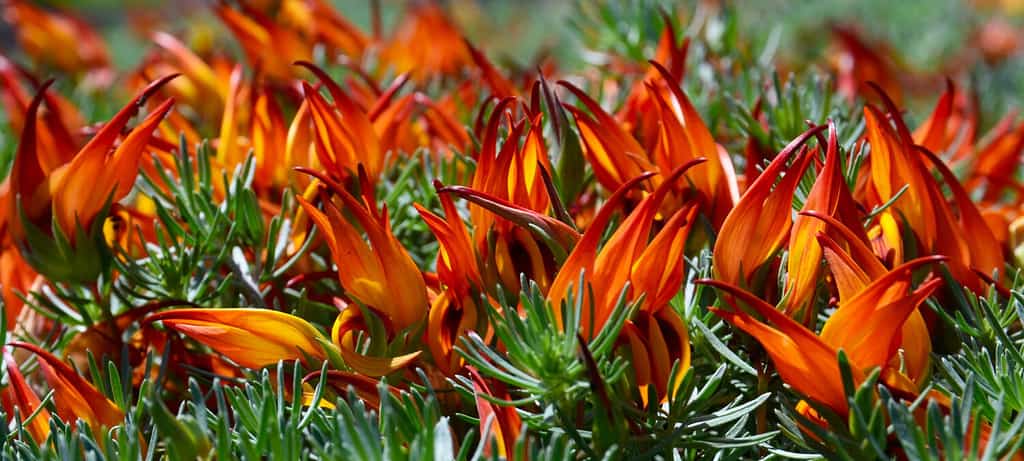
With colorful blossoms that range from orangeish-red to yellow, the lotus vine is a beautiful plant to add to your garden.
©svf74/Shutterstock.com
The lotus vine stands out with its unique trailing greenery, characterized by soft, grayish-green, needle-like foliage that forms appealing clusters along the stem. These leaves drape gracefully, much like ornate silver jewelry, providing a stark contrast to the vibrant red, orange-tipped, or yellow blossoms.
The flowers, reminiscent of parrot beaks in shape, have evolved this distinct look, likely to attract birds for pollination. Their peak blooming period is during the cooler months of spring and early summer. In regions with hotter summers, especially with warm nights, the plant might take a blooming break.
It flourishes under the sun, preferring light and well-draining soil. In hotter locales, a bit of shade is beneficial. Be attentive to its watering needs: neither too much nor too little. Ideally, keep the soil consistently moist but let the top layer dry out a bit between waterings.
This vine is a top choice for container planting or hanging baskets. It also seamlessly fits into rock and Mediterranean gardens, either as a petite groundcover or draped elegantly over walls, wherever it can withstand the winter.
This beauty is most comfortable in USDA Zones 9-12.
3. Carolina Jessamine (Gelsemium sempervirens)
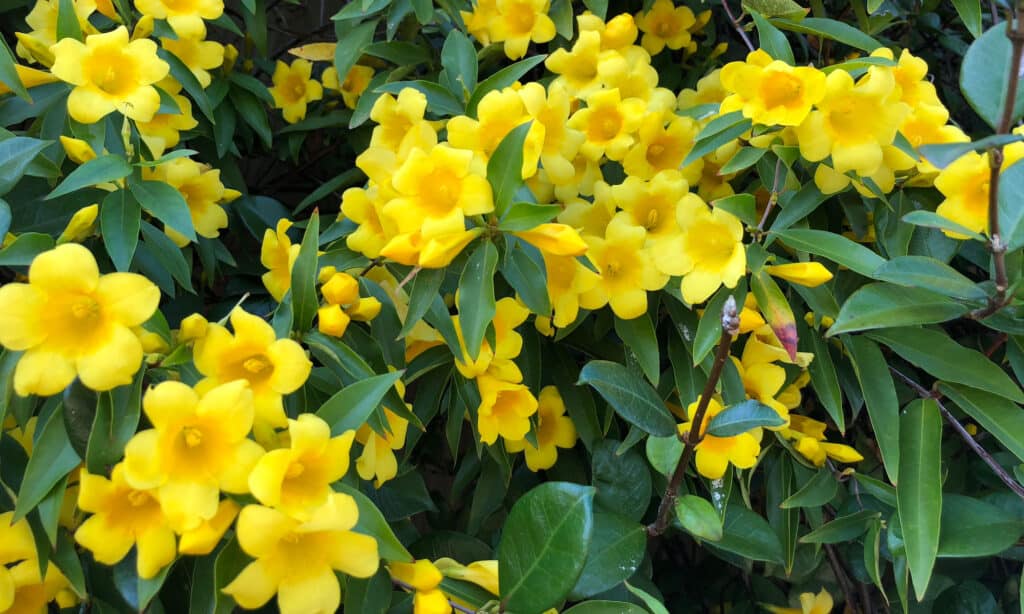
With its vibrant yellow flowers, the Carolina jessamine vine is a sight to behold in late winter or early spring. It is even the official state flower of South Carolina!
©iStock.com/Campwillowlake
The Carolina jessamine vine is a sight to behold when in full bloom. This evergreen climber showcases vibrant yellow or rich golden-yellow trumpet-shaped flowers spanning about 1.5 inches. These blossoms make their grand appearance from late winter to early spring and sometimes even surprise with a few blooms in the fall. Some might even reveal orange accents in their centers, appearing either individually or in eye-catching clusters.
The blooms of the Carolina Jessamine not only appeal to our senses but also draw in bees, hummingbirds, and butterflies, creating a lively scene. Complementing the bright flowers are the vine’s glossy, oval, light green leaves that occasionally take on yellow or purple hues in colder months.
This vine holds special significance as South Carolina‘s official flower. It has also been recognized with the renowned Award of Garden Merit by the Royal Horticultural Society.
It thrives in areas receiving full sun to partial shade and prefers organically rich, well-draining soil that retains some moisture. To experience its best bloom, ensure it’s exposed to ample sunlight and shield it from chilly, drying winds.
Signaling the arrival of spring, the Carolina jessamine elegantly drapes over trees, weaves through fences, or sprawls on the ground, creating a vibrant mat. It’s hardy in USDA Zones 6-10.
4. Yellow Passion Flower (Passiflora lutea)
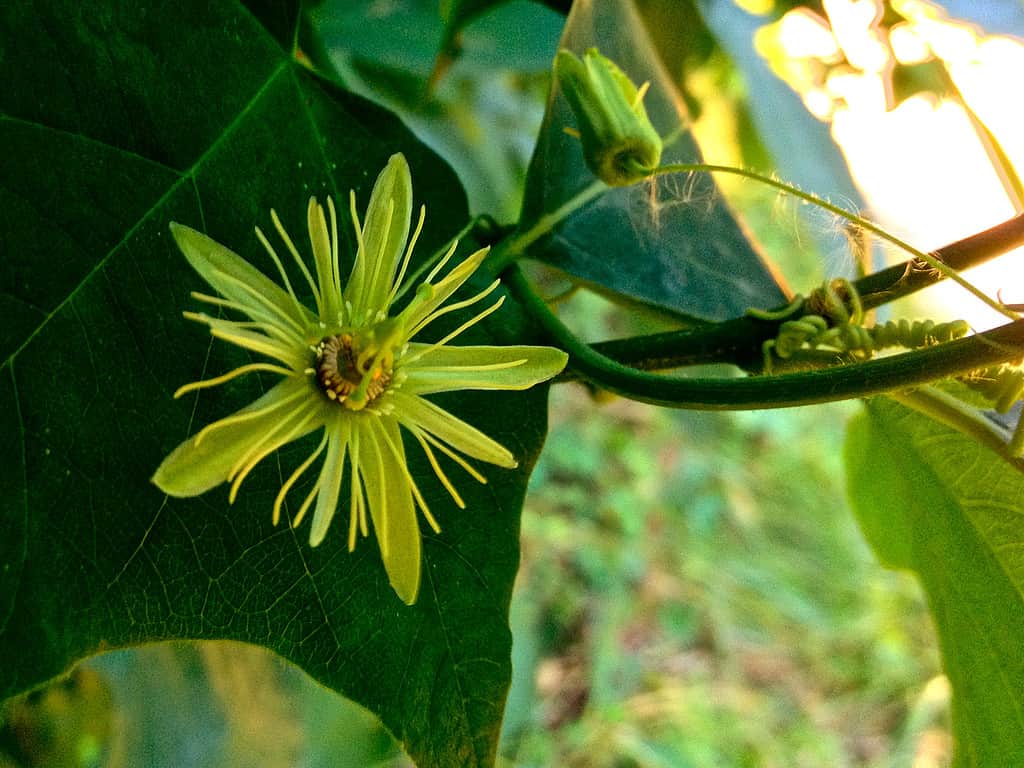
The yellow passion flower is a yellow flowering vine that grows in the warmer regions of the USA. Fun fact: this delicious flower is also edible!
©Fritzflohrreynolds / CC BY-SA 3.0 – License
Among the most resilient passion flower vines, the yellow passion flower is a radiant, herb-like vine showcasing delicate greenish-yellow or near-white blossoms about an inch wide. These aromatic flowers are a magnet for bees, butterflies, and hummingbirds, giving way to tiny black berries later on, which birds and small critters relish.
The leaves of the yellow passion flower flaunt a metallic green hue, shaped with three gentle lobes. Notably, these flowers are not just pretty but also edible, making for a fancy addition to salads. Naturally found in the eastern and south-central regions of the US, this vine beautifully blends into woodlands, forests, and coastal forests.
This vine with yellow flowers also plays a pivotal role in butterfly habitats, serving as a primary source for Gulf fritillaries, Julia butterflies, and zebra longwings.
Bursting to life in warm climates, its blooming phase spans intermittently from the later part of spring to the beginning of autumn. For optimal growth, ensure a sunny to semi-shaded spot and plant in nutrient-rich sandy or pebbly soil that drains well.
Yellow passion flower is a perfect pick for decorating trellises, walls, or fences. Moreover, this self-clinging vine won’t cause harm to your brick walls or fencing structures, thanks to its natural tendrils. It can withstand varying conditions, suitable for USDA Zones 5 to 10.
5. Yellow Mandevilla (Pentalinon luteum)
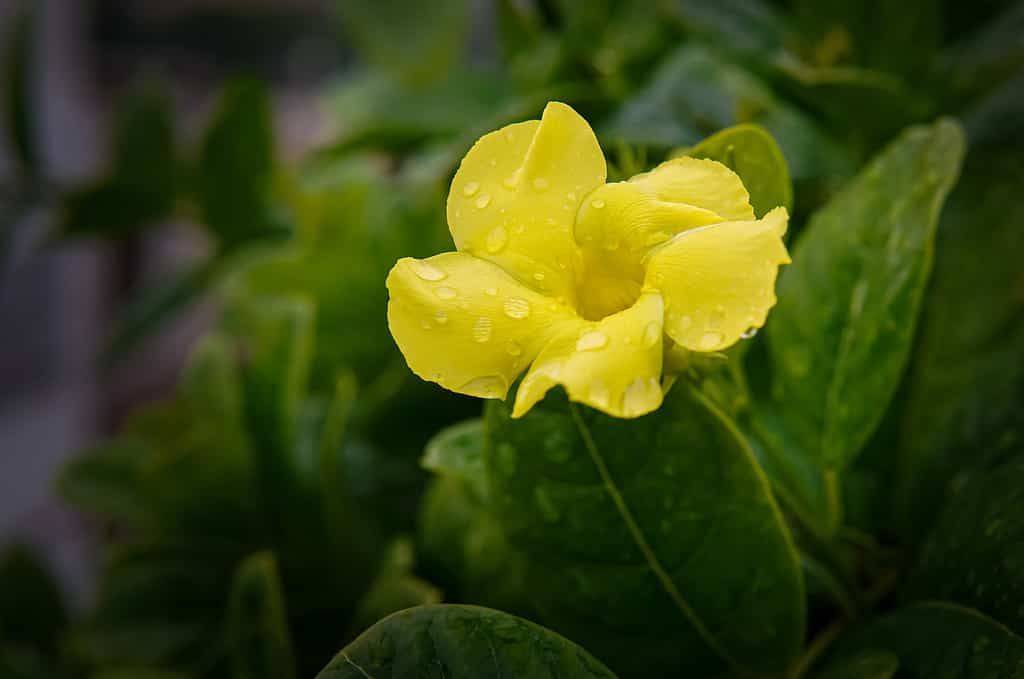
One of the most delicate flowering vines is the yellow Mandevilla, which thrives in warm environments.
©Hammad Khan/iStock via Getty Images
The yellow Mandevilla is another beautiful vine with yellow flowers. These radiant yellow blossoms feature soft-edged petals centered by a deeper golden hue. As summer progresses into early autumn, fresh flowers continue to emerge amidst a backdrop of verdant leaves.
Requiring minimal attention, this plant can gracefully adorn both gardens and pots. Imagine placing the Mandevilla in a suspended pot, allowing its tendrils to flow downwards, forming a natural tapestry of leaves.
It revels in the heat of summer and can endure both high temperatures and minimal water. Originating from tropical and subtropical regions, the exquisite flowers naturally draw in hummingbirds and bees.
Position your yellow Mandevilla where it can bask in the sunlight, preferably in a place exposed to direct sun for the majority of the day. When the soil feels dry, that’s your cue to water it. Ensure the soil is nutrient-rich with a slight acidity to neutrality and has good drainage.
For vibrant growth, a balanced liquid fertilizer applied fortnightly can work wonders. Whether you let its tendrils roam free or prune them for a denser appearance is entirely up to you.
It’s ideal for gardens in USDA zones 9 to 11.
6. Butterfly Vine (Mascagnia macroptera)
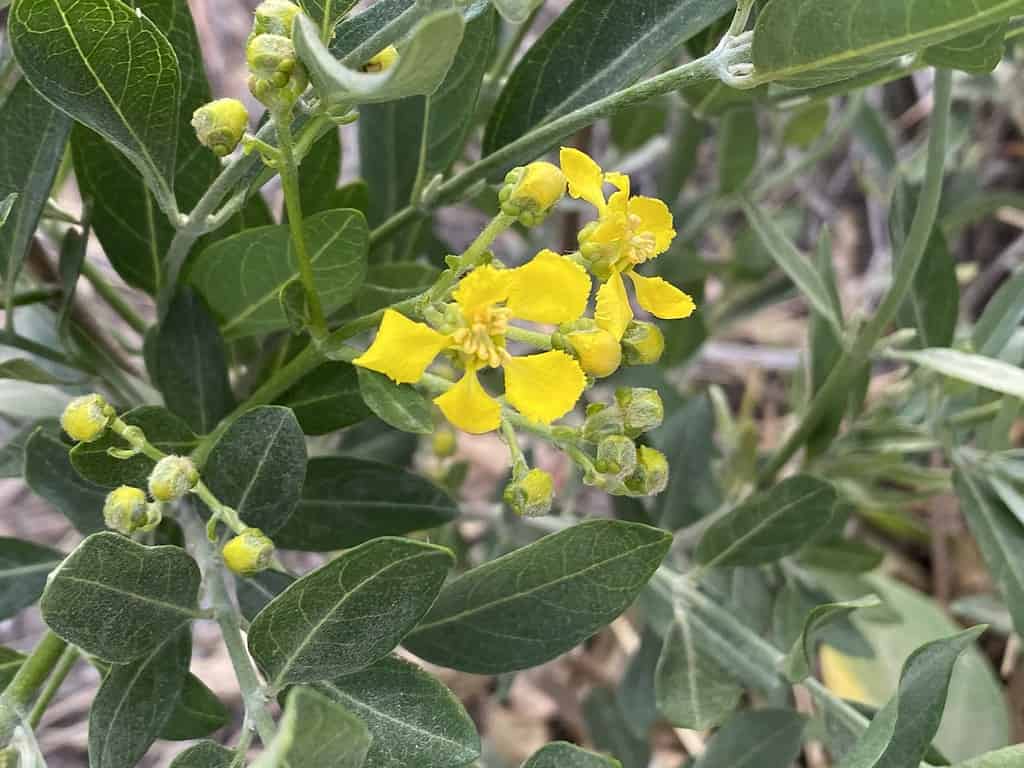
The butterfly vine thrives in heat and dry conditions and has a unique yellow orchid-like appearance.
©Daniel Alexander Carrillo Mtz / CC BY 4.0 – License
If you’re in search of a yellow flowering vine that thrives in drought and heat while showcasing, consider the butterfly vine.
This sun-adored evergreen vine reveals its beauty in late spring, flaunting vibrant yellow flowers that are reminiscent of orchids. These flowers are set against a canvas of deep green leaves. A bonus bloom session often lights up autumn. The vine gets its name from the unique seed pods that look like delicate butterflies.
It can gracefully spread both upwards and outwards, potentially covering an area of 15 feet in both directions. From spring until the first frost, its yellow orchid-like blossoms adorn gardens, soon followed by seed pods that start in a gentle green hue and deepen to brown as they age.
Ideal for sunbaked spots, butterfly vines prefer to bask in direct sunlight, though they can manage in dappled shade too. They’re easy-going when it comes to soil, only asking for good drainage. Once they take root and grow, the water needs for the butterfly vine are minimal.
It’s a top pick for gardens in the warm regions of USDA zones 8 to 10.
7. Trailing Lantana (Lantana montevidensis)
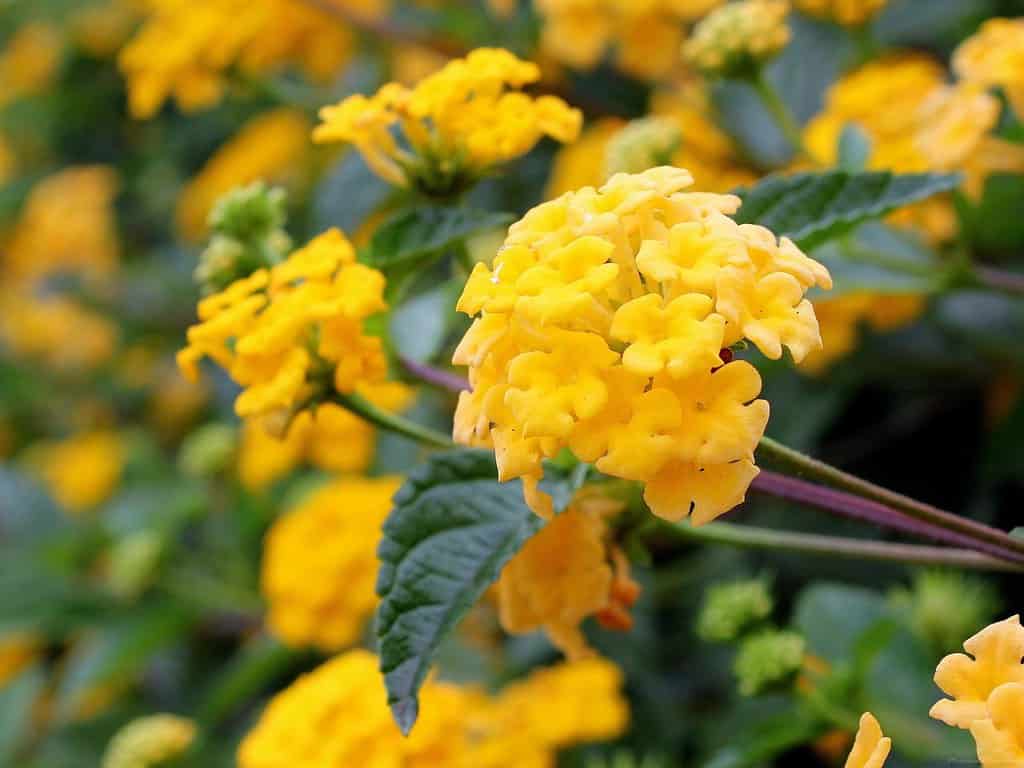
Trailing lantana is a gorgeous yellow vining plant that can be a perennial in frost-free regions.
©Attribution-NonCommercial-ShareAlike (CC BY-NC-SA 2.0) – License
A favorite among gardeners, trailing lantana offers a vibrant green carpet effect with its year-round evergreen leaves. These leaves have a distinct scent, are slightly hairy, and feature a rough edge. The vine is also dotted with small, rose-tinted lilac or yellow flowers. In regions free from frost, these flowers appear all year round.
For those in colder zones, this lantana is typically planted as a seasonal delight, showcasing its flowers from the onset of spring till autumn’s end. Bees and butterflies hover around its blossoms, making it a delightful addition to any garden. Gardeners appreciate this lantana for its sturdiness and consistent flowering.
It prefers well-draining soil and revels in sunlight, although it can manage in partial shade. However, sunnier spots encourage more blooms. Sandy and somewhat dry conditions are ideal for this plant. After settling in, it doesn’t demand frequent watering.
It’s perfect to blanket the ground, adorn coastal or cottage-themed gardens, or give Mediterranean landscapes an extra touch of charm. When potted, it spills gracefully from containers or hanging baskets. It’s best suited for gardens in USDA zones 8 through 10.
8. Black-Eyed Susan Vine (Thunbergia alata)

Another beautiful yellow vine you can plant in your garden is the black-eyed Susan vine, which is a vibrant evergreen that boasts blossoms spanning 2 inches in diameter.
©Luis Echeverri Urrea/ via Getty Images
A vibrant evergreen vine, the black-eyed Susan vine boasts beautiful yellow flowers. Gardeners typically cultivate this plant as an annual. This vine showcases lovely heart-shaped foliage and captivating yellow-orange blossoms spanning about 2 inches. Each flower boasts a deep purple-black center. Throughout summer and fall, these flowers emerge from where the leaf meets the stem.
A variety of this vine displays blooms in diverse hues, ranging from red to pink, soft yellow, apricot, and even cream, but all retain the signature dark center. With its ability to quickly scale heights, this vine serves as an excellent cover for unsightly fences or to add charm to trellises and arbors.
The vine flourishes in well-draining soil rich in organic matter, positioned in direct sunlight. In regions with intense summer heat, a little shade in the afternoons is beneficial.
While it’s a natural climber, it’s worth noting that this vine does need structures like trellises or fences to support its growth. The black-eyed Susan vine also makes a lovely sight in planters and drooping gracefully from hanging baskets. It’s ideally suited for gardens in USDA zones 10 through 11 as a perennial and zones 2 to 9 as an annual.
9. Golden Chalice Vine (Solandra maxima)
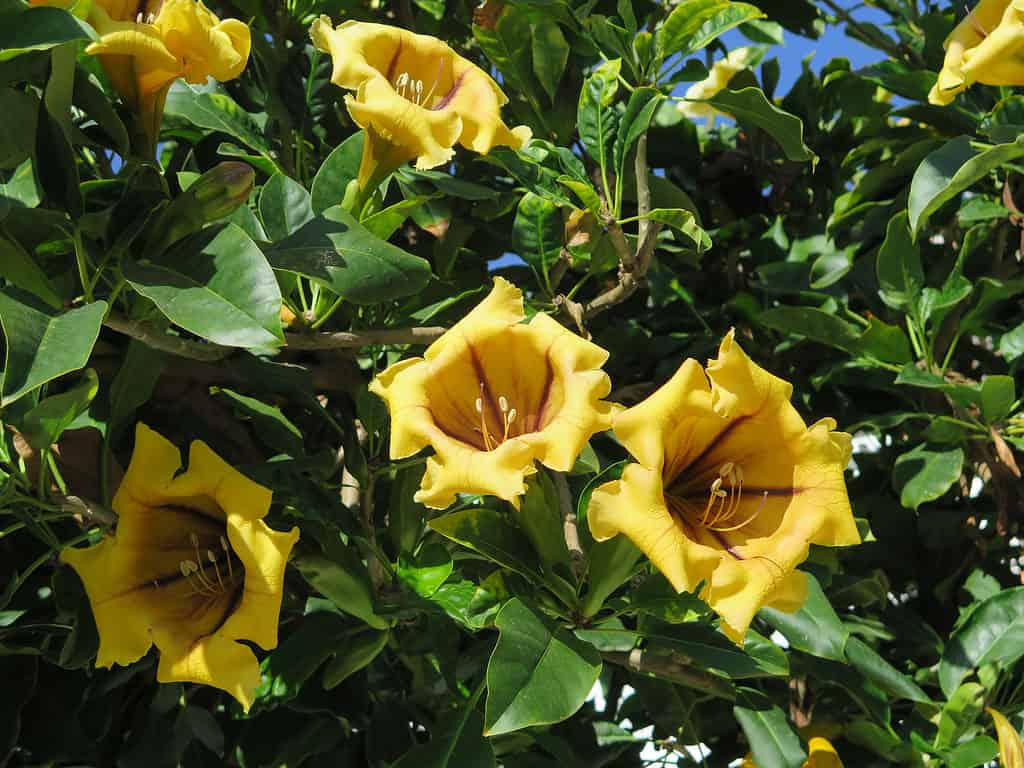
A perennial climber, the golden chalice vine boasts dark green leaves and showstopping golden-yellow flowers with swirls of purple and brown.
©Hans wrang/Shutterstock.com
Golden chalice vine is a gardener’s dream. This perennial climber naturally wraps itself around nearby plants in its natural habitat and requires sturdy support when grown in gardens. The vine is recognized for its large, goblet-like blossoms that can span up to 10 inches.
The vine sports robust, dark green leaves which can extend up to 6 inches, emerging from both the primary vine and its offshoots. Its show-stopping flowers combine bright yellow and white hues with intriguing swirls of purples and browns on their insides. As days pass, the blooms evolve to richer golden tones. These flowers unfurl their beauty at night and release an unforgettable, intense coconut scent.
Golden chalice vine is undemanding about its soil, simply requiring good drainage. Whether you position it in sunlit spots or areas with dappled shade, it thrives. Remember, given its rapid growth and weight, it’s crucial to provide this vine with a robust structure for climbing.
This vine is best suited for gardens within USDA Zones 10 and 11.
10. Yellow Honeysuckle Vine (Lonicera flava)
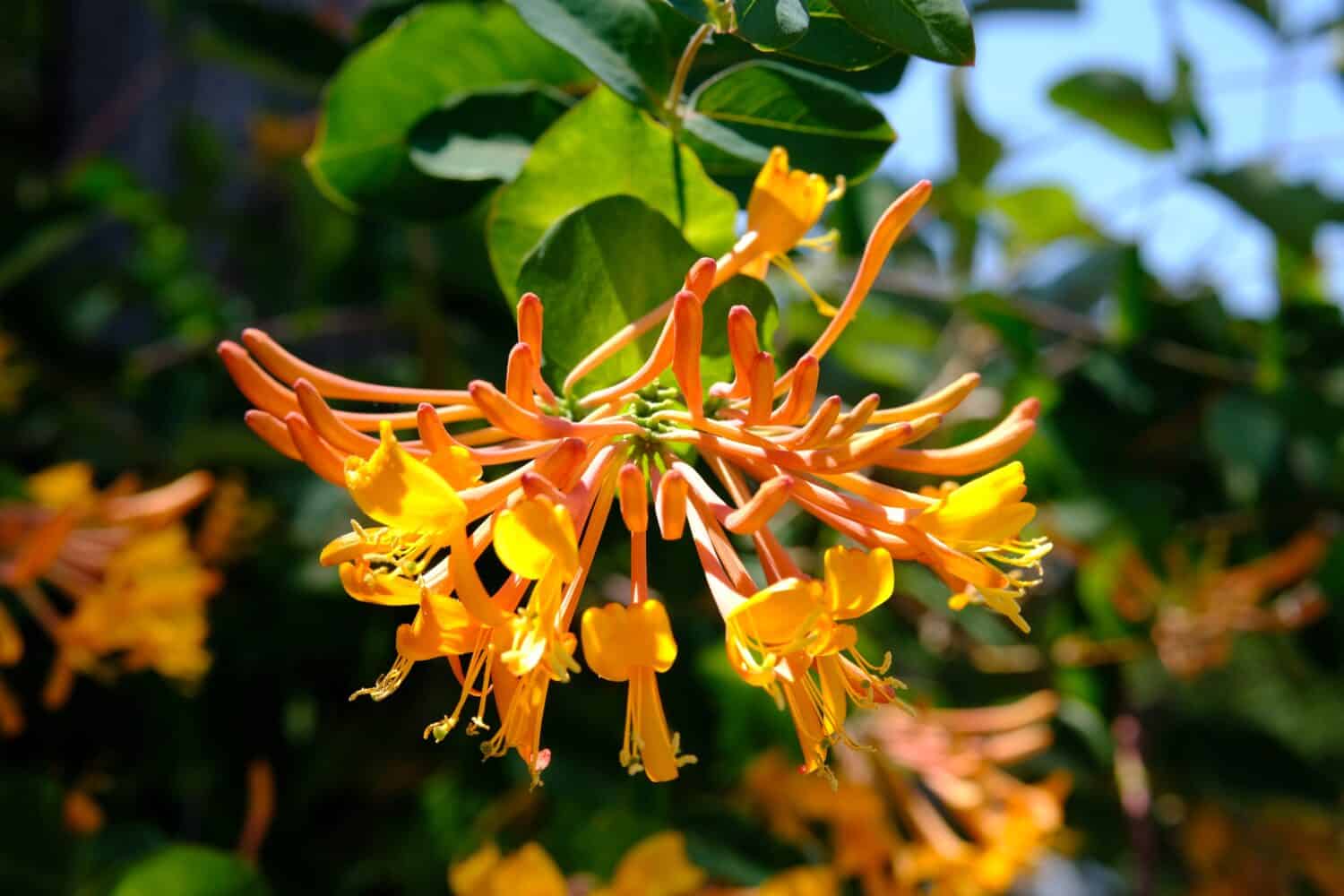
The yellow honeysuckle vine can be seen growing wild all over the southeastern U.S.
©nomis_h/Shutterstock.com
Yellow honeysuckle is a leaf-shedding vine with yellow flowers that can stretch between 10-15 feet, occasionally even reaching 20 feet. It primarily calls the southeastern U.S. its home.
Its standout feature is the slender, trumpet-like yellow blossoms that make their appearance in the late spring, arranged in circular clusters at the tips of stems. These blooms are a favorite amongst hummingbirds, butterflies, and bees.
As summer transitions to fall, this vine flaunts small, bright red berries, which, while not fit for human consumption, can add a decorative touch to gardens. Birds find these berries particularly enticing.
For optimal growth, plant the honeysuckle in a spot that gets plenty of sunlight, though it can tolerate some shade. However, for a lavish flower display, full sun is recommended. A soil rich in organic matter that drains well suits it best. This climbing plant either needs a structure to wrap itself around or can be left to spread as ground coverage. If you feel the need for a trim, do it right after it’s done flowering.
This plant best suits USDA Zones 4 through 9.
11. Golden Clematis (Clematis tangutica)
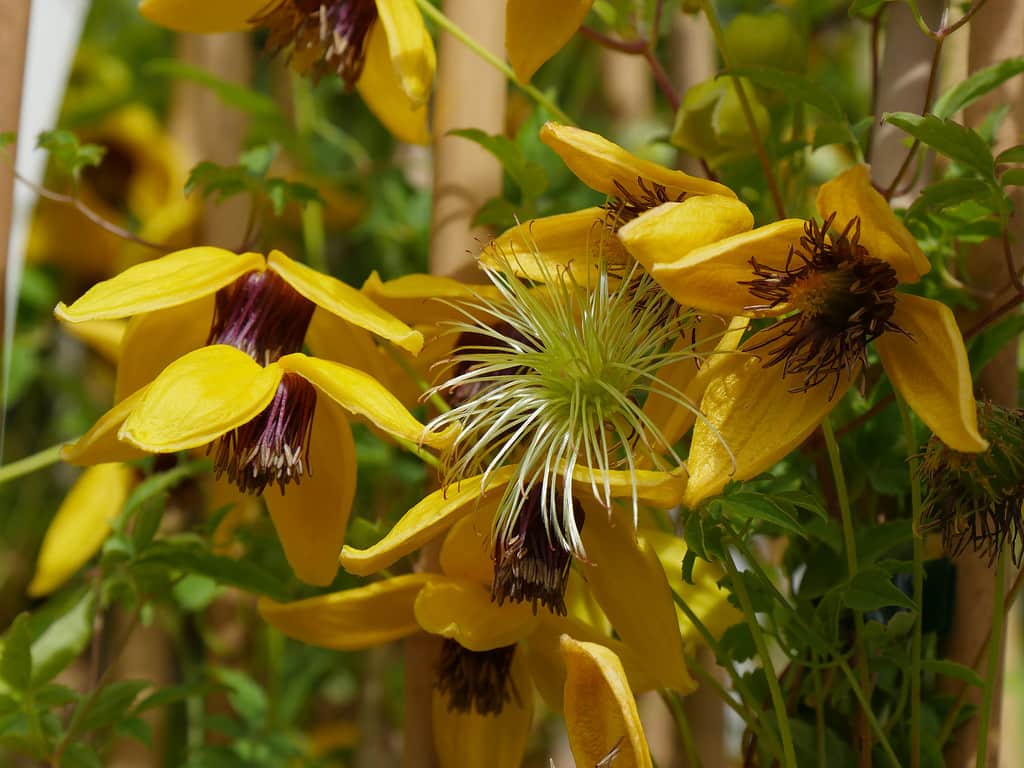
A perennial vine, the golden clematis can bring some cheerful color to your garden with its fragrant yellow blossoms — perfect for walls and fences.
©IsabelleMorand/iStock via Getty Images
Golden clematis is a perennial vine that sheds its leaves and features gentle yellow blossoms that dangle gracefully. Following its flowering phase, it adorns itself with fluffy seed clusters, often likened to the whiskers of an elderly man, leading to its informal name, the old man’s beard.
This vine is perfect for vertical spaces like walls or fences, offering a natural curtain during its blooming season. The vibrant, scented, tube-like flowers not only enhance garden aesthetics but also draw butterflies and hummingbirds, making them a valuable addition to gardens designed to attract pollinators. It seamlessly fits into Asian-themed or cottage-style gardens.
Be cautious around clematis, as ingesting it can result in mouth discomfort and ulcers. It’s toxic if consumed by dogs, cats, and horses.
To ensure its health, shield the plant’s base with mulch or other plants to keep it cool. While it’s flexible about light, a bit of shade is fine for its growth. The plant isn’t fussy about soil type but prefers a balance to slightly alkaline pH and efficient drainage. Additionally, it’s quite resilient in dry conditions.
This vine thrives best in gardens within USDA Zones 4 through 9.
12. Yellow Orchid Vine (Callaeum macropterum)
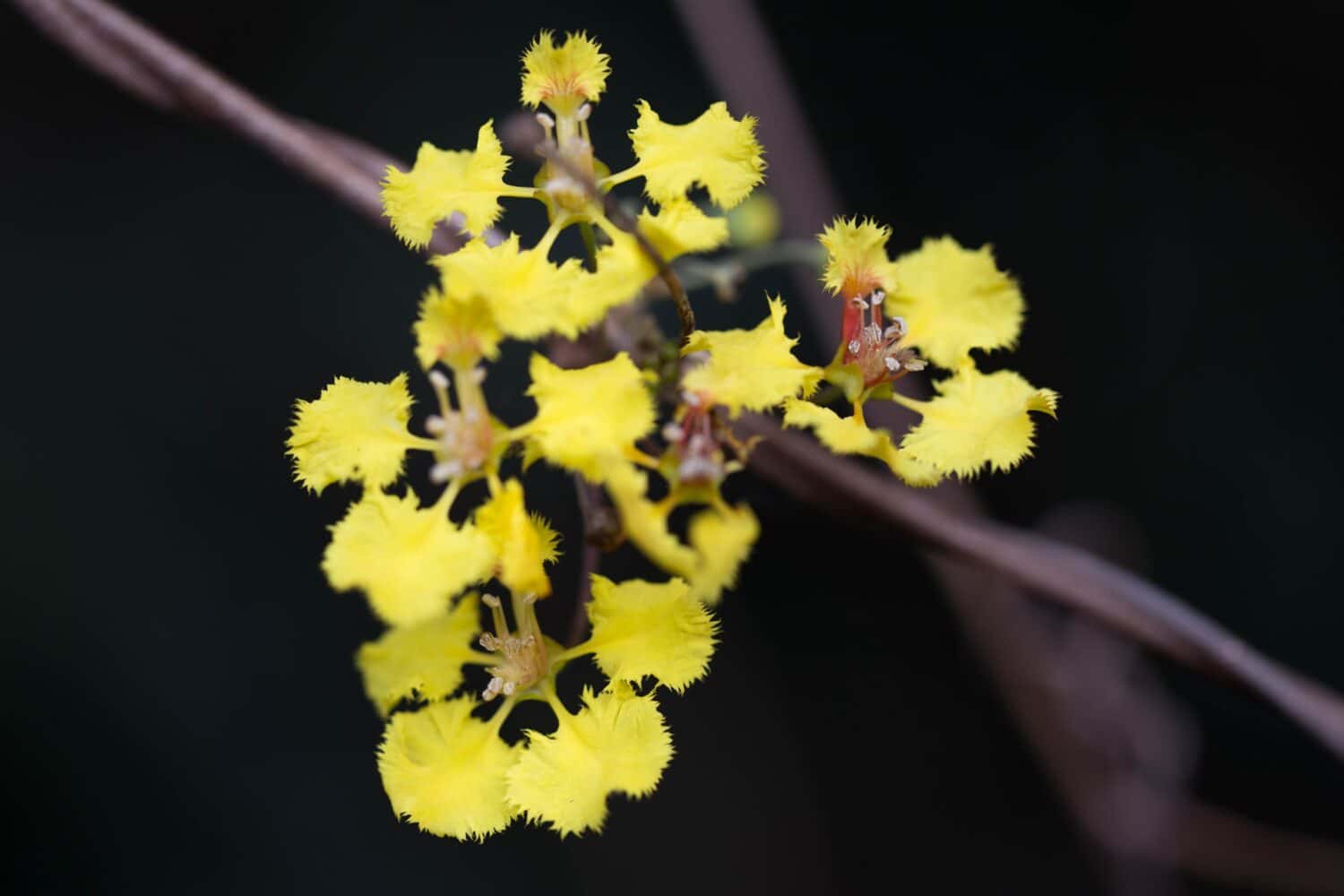
The flowers of the yellow orchid vine bloom in spring and summer.
©Ebani Brunaldi’ 85/Shutterstock.com
Originating from Baja California and Sonora, Mexico, the yellow orchid vine showcases glossy, round green foliage. Come spring and summer, vibrant yellow blooms reminiscent of orchids enhance their beauty. If left unsupported, the plant curls in on itself, taking on the appearance of a bushy shrub or even sprawling out as ground cover.
This agile vine can effortlessly stretch up to 30 feet. However, a cold winter that causes the plant to freeze may delay its spring blossoming. A unique feature of this vine is its distinct winged fruit, measuring up to two inches. Mild winters let it retain its leaves. While various insects are drawn to its flowers, bees play the central role in its pollination.
This vine flourishes under the sun’s full gaze, with shaded areas diminishing its vigor. For optimal growth during peak summer, water it once or twice a week. While it’s adaptable to various soil types, it thrives in well-draining soil.
It’s best suited for gardens in USDA Zones 8 through 10.
Summary of Vines That Have Gorgeous Yellow Flowers
| # | Vine | Botanical Name | Native to |
|---|---|---|---|
| 1 | Yellow Trumpet Vine | Campsis radicans | Southeastern United States |
| 2 | Lotus Vine | Lotus maculatus | The Canary Islands |
| 3 | Carolina Jessamine | Gelsemium sempervirens | Guatemala, Mexico & Southern US |
| 4 | Yellow Passion Flower | Passiflora lutea | Central & Eastern US |
| 5 | Yellow Mandevilla | Pentalinon luteum | Caribbean & Southern Florida |
| 6 | Butterfly Vine | Mascagnia macroptera | Mexico |
| 7 | Trailing Lantana | Lantana montevidensis | South America |
| 8 | Black-Eyed Susan Vine | Thunbergia alata | Tropical East Africa |
| 9 | Golden Chalice Vine | Solandra maxima | Mexico |
| 10 | Yellow Honeysuckle Vine | Lonicera flava | Southeastern US |
| 11 | Golden Clematis | Clematis tangutica | Central Asia |
| 12 | Yellow Orchid Vine | Callaeum macropterum | California & Mexico |
The photo featured at the top of this post is © Hammad Khan/iStock via Getty Images
Thank you for reading! Have some feedback for us? Contact the AZ Animals editorial team.







